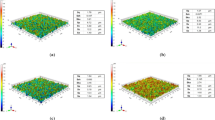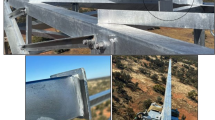Summary
Tensioning is the saw prestressing procedure most commonly used in the forest products industry to increase the stability of thin circular saws. This procedure stiffens the saw blade by introducing favorable in-plane residual stresses either by local plastic deformation or by local heating. In industry today, rolling is the standard procedure for introducing such stresses.
The first part of this paper is concerned with a method of tension evaluation. The method examined consists of measuring saw blade modal stiffness, and it correlates the elastic stiffness of the saw, which approximates the vibration modes, and the natural frequencies associated with these modes. The predictions of the saw frequency shift due to stiffness variations were found to agree closely with experimentally determined frequencies. The method thus offers a practical procedure for tension evaluation and could replace the currently used technique of measuring the light gap under a straightedge placed along the saw diameter.
The second part of this paper theoretically analyzes the relationship between the rolling load and the resulting tensioning stresses. The procedure followed in the theoretical model determines the identation load by equating the external power of loading with the power of storing in the elastic zones and of internal dissipation in the plastic zone.
The residual stresses obtained by superpositioning the stresses due to unloading were generally in good agreement with the experimentally determined tensioning stresses outside the rolled region. The theory developed can be very useful in predicting tensioning stresses for a given rolling load and roller geometry.
Similar content being viewed by others
Abbreviations
- a, b:
-
Inside and outside saw disc radii
- A, B:
-
Arbitrary constants
- c:
-
Saw disc tensioning radius
- ci, c0 :
-
Inside and outside rolling/indentation radii
- cn :
-
Neutral radius
- d:
-
Track width
- E:
-
Modulus of elasticity or strain energy
- Eext :
-
External power of the loading
- Ep :
-
Power dissipation due to plastic deformation
- Ed :
-
Power dissipation due to velocity discontinuity
- Ee :
-
Power stored in elastic zones
- fn :
-
Resonant frequency of a saw disc n — nodal diameters
- f TMn :
-
Measured resonant frequency
- f TCn :
-
Resonant frequency calculated from the variation in the saw disc stiffness
- F:
-
Rolling load
- H:
-
Half saw disc thickness
- Kn :
-
Modal stiffness, n=number of nodal diameters
- K *n :
-
Conventional or bending stiffness
- K **n :
-
Geometric or tensioning stress stiffness
- K Tn :
-
Modal stiffness of a tensioned saw disc
- Mn :
-
Modal mass, n=number of nodal diameters
- M, N:
-
Integration constants
- Pave :
-
Average indentation pressure
- p, p′, p′':
-
Radial pressures at elastic-plastic boundaries; loading, unloading and residual
- pi, pO :
-
Radial pressures inside and outside the elastic-plastic boundaries
References
Avitzur, B. 1964. Forging of hollow discs. Israel J. Tech. 2 (3): 295–304
Carlin, J. F.; Appl, F. C.; Bridwell, H. C.; DuBois, R. P. 1975. Effects of tensioning on buckling and vibration of circular saw blades. J. Eng. Ind. (2): 37–48
Dugdale, D. S.; Squires, B. A. 1965. Effect of radial load on the flexural stiffness of a thin disc. J. Mech. Phys. Solids. 13: 237–245
Dugdale, D. S. 1968. Flexure of thin plates containing internal stress. Int. J. Eng. Sci. 6: 239–249
Eldredge, K. R.; Tabor, D. 1955. The mechanism of rolling friction. I. The plastic range. Proc. Roy. Soc. London, Series A, 299: 181–198
Hackenberg, P. 1974. Spannungen in mechanisch und thermisch vorgespanten Kreissägeblättern. Diss., T.H. Aachen
Hawkyard, J. B.; Johnson, W. 1967. An analysis of the changes in geometry of a short hollow cylinder during axial compression. Int. J. Mech. Sci. 9: 163–182
Huber, H. 1977. Director, Institut für Werkzeugforschung (IFW), Remscheid, Germany. Personal communication
Kay, G. J.; Mote, C. D., Jr. 1976. Natural frequencies in an annular plate with membrane stresses by the Galerkin method. Univ. Calif. For. Prod. Lab., Richmond, Calif., Technical Report No. 5 (File Report No. 35.01.130)
Kimura, S.; Ando, N. 1974. Studies on tensioning of circular saw by rolling pressure. Part 1. J. Jap. Wood Res. Soc. 20 (5): 196–204
Kimura, S.; Ito, M. 1976. Studies on tensioning of circular saw by rolling pressure. Part 2. J. Jap. Wood Res. Soc. 22 (3): 139–145
Lahoti, G. D.; Kobayashi, S. 1974. On Hill's general method of analysis for metal-working proceses. Int. J. Mech. Sci. 16: 521–540
Mote, C. D., Jr. 1964. Circular saw stability—a theoretical approach. For. Prod. J. 14 (6): 244–250
Mote, C. D., Jr. 1965. Free vibration of initially stressed circular discs. Trans. ASME 87B (2): 258–264
Mote, C. D., Jr. 1970. Formulation of discrete element models for the stress and vibration analysis of plates. Univ. Calif. For. Prod. Lab., Richmond, Calif. Technical Report No. 35.01.77
Mote, C. D., Jr.; Nieh, L. T. 1971. Control of circular disk stability with membrane stresses. Exp. Mech. 11 (11): 490–498
Mote, C. D., Jr.; Holøyen, S. 1975. Confirmation of the critical speed stability theory for symmetrical circular saws. Trans. ASME, 97B (3): 1112–1118
Mote, C. D., Jr.; Szymani, R. 1977. Principal developments in thin circular saw vibration and control research. Part 1: Vibration of circular saws. Holz Roh- Werkstoff 35 (5): 189–196
Pahlitzsch, G.; Friebe, E. 1973. Über das Vorspannen von Kreissägeblättern. 2. Mitteilung: Rechnerische und experimentelle Ermittlung der Vorspann-Spannungen in Sägeblättern. Holz Roh-Werkstoff 21 (12): 457–463
Pahlitzsch, G.; Friebe, E. 1974. Über das Vorspannen von Kreissägeblättern. 3. Mitteilung: Einfluß des Vorspannens auf die Steifheit und das Schwingungsverhalten von Sägeblättern. Holz Roh- Werkstoff 32 (1): 5–12
Pahlitzsch, G. 1977. Professor Emeritus, Lehrstuhl für Werkzeugmaschinen und Fabrikbetrieb. Technische Hochschule Braunschweig, Germany. Personal communication
Powell, M. J. D. 1964. An efficient method for finding the minimum of a function of several variables without calculating derivatives. The Computer Journal 7 (2): 155–162
Szymani, R. 1973. Evaluation of tensioning stresses in circular saws. Proc. Fourth Wood Mach. Seminar, Univ. of Calif. For. Prod. Lab. Richmond, California, 23–27
Szymani, R.; Mote, C. D., Jr. 1974. A review of residual stresses and tensioning in circular saws. Wood Sci. Tech. 8 (2): 148–161
Szymani, R.; Mote, C. D., Jr. 1977a. Circular saw stiffness as a measure of tension. For. Prod. J. 27 (3): 28–32
Szymani, R.; Mote, C. D., Jr. 1977b. Principal developments in thin circular saw vibration and control research. Part 2: Reduction and control of saw vibration. Holz Roh- Werkstoff 35 (6): 219–225
Szymani, R. 1977. Theoretical and experimental analysis of circular saw tensioning. Ph.D. thesis. U.C. Berkeley
Thrasher, E. W. 1972. Eleven million trees wasted annually. Thrasher Publications. Ukiah, California, pp. 18–19
Author information
Authors and Affiliations
Additional information
The Authors would like to express their gratiude to C. H. Zierdt and J. Rhemrev for assistance in the experimental investigations. The authors are also grateful to Hanchett Co. and California Saw Knife and Grinding, Inc. for supplying stretcher rolls and experimental saw discs, respectively. They are also grateful for the financial support of the project from the U.C. Forest Products Laboratory, California Cedar Products Co., California Saw Knife and Grinding, Inc., Hudson Lumber Co., MacMillan Bloedel Research Ltd., Potlatch Corp., Simpson Timber Co., Sun Studs, Inc. and Weyerhaeuser Co. Finally, the authors thank the National Science Foundation for its generous support of the research
Rights and permissions
About this article
Cite this article
Szymani, R., Mote, C.D. Theoretical and experimental analysis of circular saw tensioning. Wood Sci. Technol. 13, 211–237 (1979). https://doi.org/10.1007/BF00350225
Received:
Issue Date:
DOI: https://doi.org/10.1007/BF00350225




